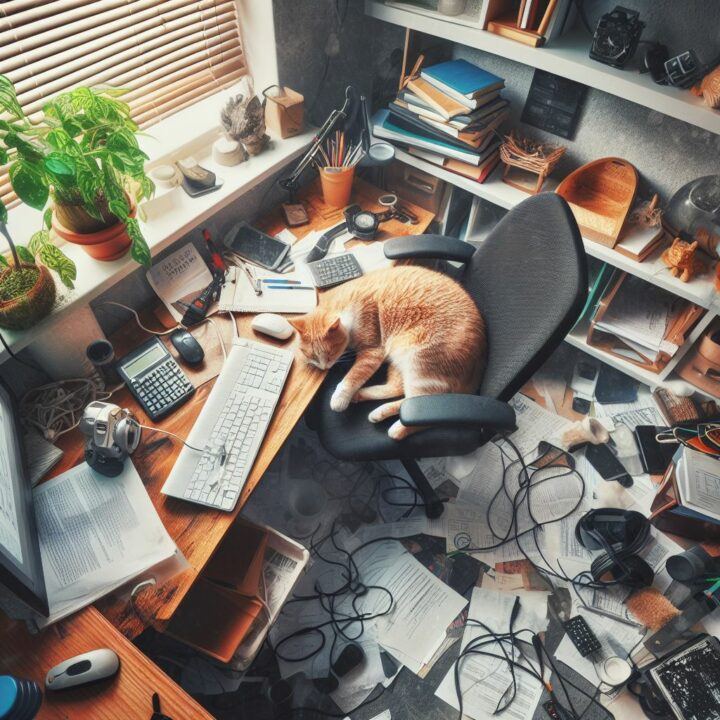Implementing minimalist organization in a home office involves several simple steps. First, declutter your space by getting rid of any unnecessary items. Next, categorize and organize your belongings into designated areas or storage solutions to keep everything easily accessible. Consider using minimalist furniture and storage options to maximize space and create a clean aesthetic. Additionally, adopt a minimalist approach to decorating by choosing a few key pieces that bring joy and inspiration to your workspace. Finally, establish a daily routine for tidying up and maintaining the organized space. By following these steps, you can create a calm and functional home office that supports your work goals.
Evaluate your current setup
To evaluate your current setup, start by taking a comprehensive look at your home office. Follow these steps to identify areas that need improvement:
- Remove clutter: Assess the amount of clutter in your workspace. Clear out any unnecessary items, such as old documents, broken equipment, or outdated supplies. This will help create an organized and efficient environment.
- Identify unnecessary items: Look for any items that are not essential to your work. Determine if you can remove or relocate them to free up space and improve functionality.
- Evaluate storage solutions: Examine your current storage solutions and assess their efficiency. Are you maximizing the use of shelves, drawers, or cabinets? Consider if there are better storage options available that can help you keep your workspace tidy and accessible.
- Optimize workspace layout: Take a critical look at the arrangement of your furniture and equipment. Ensure that your desk, chair, and computer are ergonomically positioned to promote comfort and productivity. Consider rearranging items to create a more functional and visually appealing setup.
By following these steps, you can evaluate your current home office setup and identify areas for improvement. Taking the time to declutter, remove unnecessary items, and optimize storage solutions will help create a more efficient and organized workspace.
Declutter and purge
Start by decluttering your workspace and getting rid of items that are no longer needed or used. Sort through your belongings and make decisions on what to keep, donate, or discard. Separate items into different categories based on their usefulness and sentimental value. Set aside a specific time to dedicate to this task and commit to completing it. Take one item at a time and ask yourself if it serves a purpose or brings you joy. If not, place it in the appropriate pile for donation or disposal. Keep only the items that are essential and truly meaningful to you.
Organize essentials
To organize the essentials after decluttering, start by categorizing your items. Sort them into groups based on their type or function. Then, find suitable storage solutions for each category. Utilize labels, bins, and shelves to keep things organized and easily accessible. Place items in their designated storage spaces and make sure to label them accordingly. This way, you can quickly locate and retrieve what you need when you need it.
Create a paperless system
To create a paperless system and minimize paper clutter, follow these steps:
- Scan your important papers using a scanner or smartphone app.
- Save the scanned documents in organized digital folders on your computer or cloud storage.
- Use clear and descriptive file names to easily locate documents later.
- Consider using OCR (Optical Character Recognition) software to make the scanned documents searchable.
- Regularly back up your digital files on external hard drives or cloud storage services.
- Ensure that your chosen storage method is secure and encrypted to protect sensitive information.
Optimize desk space
To maximize your desk space, keep only essential items within arm’s reach. Utilize desk organizers, trays, and cable management solutions to maintain a tidy workspace, free from distractions.
Implement a filing system
To implement a filing system, start by gathering all the important documents and papers that you need to keep physically. Next, label folders or binders according to categories that make sense for your needs, such as “bills,” “insurance,” or “taxes.” Once labeled, place each document or paper in the corresponding folder or binder, ensuring that they are stored in an organized manner. For example, you can have a folder labeled “bills” where you store all your monthly utility bills, and another folder labeled “bank statements” where you keep your monthly bank statements. This way, when you need to find a specific document, you can easily locate it in the correct folder or binder.
Utilize vertical storage
To utilize vertical storage, start by installing shelves or wall-mounted organizers. Measure the desired height and width for the shelves, making sure they are securely attached to the wall. Arrange books, supplies, or decorative items on the shelves, keeping in mind the weight distribution. This will free up desk space and provide additional storage options.
Establish a daily organizing routine
To establish a daily organizing routine, make it a habit to spend a few minutes each day maintaining the organization of your home office. Put items back in their designated places, clear off your desk, and ensure everything is tidy before leaving.
For example:
- At the end of each workday, take a few minutes to sort through any loose papers or files on your desk. File away important documents and discard any unnecessary clutter.
- Return any office supplies or tools to their designated storage areas. This could include pens, staplers, or reference materials.
- Take a moment to wipe down your workspace and keep it free from dust or debris. This will not only help maintain cleanliness but also create a more pleasant working environment.
- If you have any electronic devices or cables on your desk, neatly arrange them and keep them organized to prevent tangling or confusion.
- Lastly, give your office area a quick visual check to ensure everything is in order before you leave. This will help you start the next day with a clean and organized workspace.
By following these simple steps daily, you can establish an organizing routine that will help you stay productive and focused in your home office.
Minimize distractions
To eliminate unnecessary distractions from your home office, start by keeping personal items and non-work-related items to a minimum. Clear your workspace of anything that may divert your attention from your tasks. Consider using noise-cancelling headphones to block out any surrounding noises or creating a designated quiet space where you can focus on your work without interruptions.
Regularly review and adjust
Periodically review your minimalist organization system and make necessary adjustments. Evaluate your storage solutions and workspace layout to ensure they are still meeting your needs effectively. If you find that certain items are no longer being used or that your current setup is causing clutter, take the initiative to reorganize and declutter your space accordingly. By regularly reviewing and adjusting your organization system, you can maintain an efficient and clutter-free environment that supports your productivity and overall well-being.
Key Takeaways
- Implementing minimalist organization in your home office can have a profound impact on your productivity and focus.
- By following the steps outlined in this blog post, you can transform your workspace into a clutter-free and organized area.
- Embracing simplicity and minimalism will not only improve your efficiency but also create a more enjoyable and stress-free working environment. So, take the first step towards a minimalist home office and enjoy the benefits it brings.

Essential Supplies
Efficient Workspace Solutions
Getting Started with Minimalist Organization
- Declutter: Start by going through your belongings and getting rid of items you no longer need or use. This will help create more space and allow you to focus on what truly matters
- Simplify your space: Arrange your belongings in a way that promotes simplicity and functionality. Keep only the essentials and find designated spots for each item. This will make it easier to find things when you need them and maintain a clean and organized space
- Adopt a minimalist mindset: Embrace the idea of living with less and prioritize experiences and relationships rather than material possessions. This mindset shift will help you make intentional choices about what you bring into your life and allow you to let go of excess stuff more easily
- Create routines: Establish simple routines for cleaning, organizing, and maintaining your space. By incorporating these habits into your daily or weekly schedule, you’ll prevent clutter from accumulating and maintain the minimalist organization you’ve worked hard to achieve
- Embrace digital solutions: In today’s digital age, take advantage of technology to minimize physical clutter. Digitize documents, photos, and other important files, and consider using apps or online tools for tasks such as note-taking, task management, and budgeting. This will help reduce the need for physical storage and streamline your organizational efforts
- Remember, minimalism is a personal journey, and it’s important to adapt these principles to fit your own lifestyle and preferences. Happy organizing!


